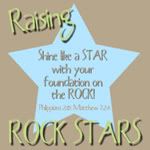You may want to read the past two blogs to get updated on where we are. I am now reading the second part of the book, All Children Flourishing. The second part is called, The Parent's Guide to the Nurtured Heart Approach. I am still in love with this approach. It's a totally different way of thinking when it comes to discipline. I have begun to implement it in my own family and it takes some getting use to because it is not what comes naturally. It is so easy to point out what is going wrong and use language to try to fix the wrongs all the time, but I am committed to sticking to it. I think it is worth trying as I want to build up my son to have confidence, strength and courage. I think it may just rub off on Brian and I as well!
So I keep reading...Chapter 5 talks about the "stands" and the methods with this approach to parenting/discipline. Howard Glasser states that at the core of the Nurtured Heart Approach is the ability to zero in on what's going right instead of giving all our energy to our children when things are going wrong. Let's review the four underlying concepts of the Nurtured Heart Approach that we've examined so far. 1. We are our child's favorite toy. They can make us "pop" and react easily, but it is important for us to control when we "pop" and how. 2. Catching goodness vs. Creating goodness; Shamu 3. Choosing the way we see things; recognizing success and celebrating those successes. 4. Clear rules, Clear consequences and right back in the game of greatness; Video Game Theory.
Now let's take a look at the three stands. The Nurtured Heart Approach is founded on these three stands. Each stand is supported by the four underlying concepts. Essentially they are the "commandments" of this approach. The key in using these stands is not perfect execution. No one is perfect and these stands may get broken from time to time. They hopefully will become motivation or guideposts to help us get back on track when needed. Stand I: The relentless pursuit and celebration of positivity. Stand II: Strict Rule Enforcement. Stand III: Not leaking negativity. Glasser uses an illustration of a three legged table. Keep all three legs in place and your table won't topple. And if you see it wobbling, act quickly to get it steady once again. For me, this means I must be honest with myself. To accept that I make mistakes and may not always be handling situations in the best way. I have experienced this while teaching. I have apologized to more than one student in my teaching experiences so far because of how I may have reacted in a situation. I am not perfect. I do fall short. It has been humbling and enlightening to accept that and be vulnerable in those situations. It surely has strengthened relationships with students and peers as well as in my own marriage.
Today I will focus on just one method. Glasser encourages us to start applying each method/technique on its own before going onto the next. So I am working on the first one now. It is called Active Recognition. This technique is all about observing and verbalizing what the child is actually doing, without judgement or evaluation. Glasser refers to it as a "verbal snapshot". For example: "I see you are using red, yellow and green yarn to make your weaving." "I can hear that you and your other group members are collaborating on your homework project." "I see that you are really angry right now and I see that you are handling it beautifully." Basically we are showing the child that they are not invisible. We are sending the message that they are being seen, acknowledged and appreciated. Glasser emphasizes that we only do this when the child is doing something positive, never when they are doing something wrong. Once a child has crossed the line, it's consequence time. This technique is used to help wire a child toward positivity. Children may rebel against this technique, especially if they are use to us pointing out what they are not doing right. Glasser tells us to not give in! Stay away from being sucked into that negativity. (Stand III) It is good to acknowledge that we are trying to be more positive and use our energy and interaction by noticing each other in positive ways. When applying this technique, Glasser tells us to use neutral, non-judgemental language to make the message as "digestible" as possible. Children may resist this technique, but they can't argue or deny direct observations that we give. Also, Glasser writes to be as specific as possible. "Good job, "thank you" or even "that's beautiful" with all the emotion and good intentions in the world isn't going to help the child know exactly what you mean. Glasser makes great empahsis on using this technique to help support children with healthy experessions of emotions. So often parents tell their children to "Stop crying.", "Stop acting so angry, no one did anything to you!", "Don't you start crying!", "Don't be a baby!" We may be trying to help our children be stong on the inside, but encouraging them to hide their feelings will not help them grow stronger. Instead, we are acknowledging that they do experience emotions and show strength by handling them in healthy ways. I can only imagine how frustrated children can fell when they are dealing with strong emotions. Even after 30 plus years of experiencing life, I don't always know how to handle emotions like grief, envy, dissapointment and anger, to name a few. Glasser says that even asking children to talk about how they are feeling and why they are feeling that way doesn't help. It's the acknowledgement, support and unconditional love that helps a child find greatness within even in the midst of emotions. I want to end this blog by sharing more examples Glasser gives for Active Recognition. The latter ones deal specifically with connecting qualities of greatness with the verbal snapshots we give to our children. I hope they are helpful to you. I am alway open to hearing your thoughts. Let me know how it is working for you if you choose to try this technique. I know my son is still very young, but I am enjoying sharing these snapshots with him. I am even trying to do it more with my husband. I don't think I give him enough recognition and acknowledgement during a regular day. I say "thank you" too much! It's been fun to work on my vocabulary!
More examples for Active Recognition: "Jo, I see you are building a tower with colored blocks and you are being extremely careful as you place them to keep the tower balanced!" "Paul, I can tell you are eager to go outside." "Erin, you're gluing colored paper scraps to your project. I see pink, purple adn green scraps in your pile and you're connecting them at all kinds of interesting angles." "Tom, I saw how those kids were annoying you and how you chose to not give them any enery. And I also can tell you are frustrated, and you are handling that strong feeling well. I really appreciate how powerful you are being, not taking your anger out on those kids or anyone else. That power is a great quality you have." "Bob, I noticed you wiping down the counter after dinner. I know it's your job, but I just really appreciate that you do this so well and take it seriously and hardly ever need to be reminded. Your helpfulness is a quality of greatness that I admire in you."
One last thought... When I first read these, I thought they were strange and drawn out, but the more I thought about it, I realized that when children usually do something wrong, adults tend to get at their level and have this conversation asking the child what they did, why they did it and what should they have done. So it's really very much the same thing, except it's done when the child is doing the right things, reinforcing the activity and actions that we want to see them doing, instead of trying to tell them what they should be doing when they are not doing it....giving energy and "popping" at the right time. I think I am getting this, Howard Glasser!
Tuesday, October 28, 2008
Subscribe to:
Post Comments (Atom)















No comments:
Post a Comment